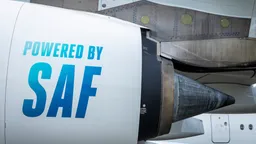15 CEOs, 70+ companies and NGOs like T&E, have sent a letter to European policymakers outlining five key policy interventions to unlock EU leadership for e-SAF.
E-SAF can realise 90% less greenhouse gas emissions over its lifecycle compared to fossil jet fuel and could abate 400 million tonnes of CO2 globally by 2050. On top of that, the EU is home to 60 percent of announced global e-SAF production capacity globally and could lead the unlocking of a EUR 350 billion global e-SAF market by 2050.
While around two million tonnes of e-SAF production capacity has been announced in Europe, no Final Investment Decisions (FIDs) have been reached. And less than 300 thousand tonnes of capacity is on track to be operational by 2030 – only half of what is required to meet the sub mandate under ReFuelEU (and even these face challenges).
The coalition of signatories is proposing five key policy interventions to help accelerate these efforts to get projects to Final Investment Decision and kick-start the industry:
1. Strategic priority in the Clean Industrial Deal and the Sustainable Transport Investment Plan (STIP): The European Commission should include e-SAF as a strategic priority in the Clean Industrial Deal and as a critical part of the Sustainable Transport Investment Plan, helping drive the scale-up from innovation to commercialisation.
2. Recycle ETS revenues from aviation to capitalise a market intermediary that enters auctioned, 10-15-year contracts with e-SAF producers and 3-5 year contracts with off-takers: Recycling ETS revenues via SAF Allowances is critical for the continued competitiveness of airlines, but doesn’t benefit e-SAF projects which require long-term offtake contracts to make first-of-a kind e-SAF plants bankable. ETS revenues from aviation could be used to capitalise a market intermediary to provide the minimum level of public support required for revenue certainty.
3. Establish a bridging mechanism in 2025 until a capitalised market intermediary comes online, to give first movers priority access to the new funding instrument: Only the first pioneering large-scale e-SAF projects will reach FID by 2025-27 – a requirement to be operational by 2030/31 and have a realistic chance of contributing to the EU’s initial e-SAF sub-mandates. To avoid delaying action while a capitalised market intermediary is being operationalised (1-2 years), the European Commission should guarantee priority access to this market intermediary for these pioneering projects.
4. Provide long-term certainty over mandates, production criteria and penalties: The EU should use proactive communications to remove uncertainty around continued enforcement of e-SAF mandates post-ReFuelEU Aviation review in 2027, as well as continued enforcement of current e-SAF production criteria. Members States should also publish harmonised penalty guidance as soon as possible.
5. Mitigate project-on-project risk via government-backed backstop mechanism: To mitigate the challenges e-SAF project developers face in financing dedicated production facilities for renewable electricity and CO2, the European Commission should establish a financial backstop ensuring debt service payments can be made until such facilities become operational.


